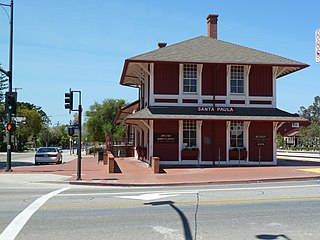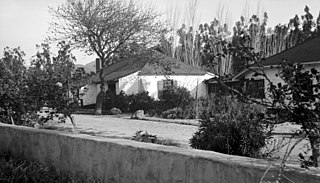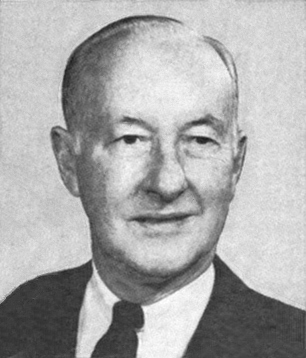
Santa Paula is a city in Ventura County, California, United States. Situated amid the orchards of the Santa Clara River Valley, the city advertises itself to tourists as the "Citrus Capital of the World". Santa Paula was one of the early centers of California's petroleum industry. The Union Oil Company Building, the founding headquarters of the Union Oil Company of California in 1890, now houses the California Oil Museum. The population was 30,657 at the 2020 census, up from 29,321 at the 2010 census.

The Santa Clara River is an 83 mi (134 km) long river in Ventura and Los Angeles counties in Southern California. It drains parts of four ranges in the Transverse Ranges System north and northwest of Los Angeles, then flows west onto the Oxnard Plain and into the Santa Barbara Channel of the Pacific Ocean.

Sunkist Growers, Incorporated is an American citrus growers' non-stock membership cooperative composed of 6,000 members from California and Arizona headquartered in Valencia, California. Through 31 offices in the United States and Canada and four offices outside North America, its sales in 1991 totaled $956 million. It is the largest fresh produce shipper in the United States, the most diversified citrus processing and marketing operation in the world, and one of California's largest landowners.

Rancho Camulos, now known as Rancho Camulos Museum, is a ranch located in the Santa Clara River Valley 2.2 miles (3.5 km) east of Piru, California and just north of the Santa Clara River, in Ventura County, California. It was the home of Ygnacio del Valle, a Californio alcalde of the Pueblo de Los Angeles in the 19th century and later elected member of the California State Assembly. The ranch was known as the Home of Ramona because it was widely believed to have been the setting of the popular 1884 novel Ramona by Helen Hunt Jackson. The novel helped to raise awareness about the Californio lifestyle and romanticized "the mission and rancho era of California history."

Saticoy is an unincorporated community in Ventura County, California, United States. The site of one of the largest settlements of the Chumash region, a settlement was laid out in 1887 along the railroad line that was being built from Los Angeles through the Santa Clara River Valley to the town of San Buenaventura. Although the town was 10 miles (16 km) distant at that time, the City of Ventura grew to a point where only a small residential and commercial community is left outside the city limits. For statistical purposes, the United States Census Bureau has defined that community as a census-designated place (CDP).
Bardsdale is a rural unincorporated community and populated place in Ventura County, California. It is located in the orange blossom and agricultural belt of the Santa Clara River Valley, south of the Santa Clara River and on the north slope of South Mountain. The closest town is Fillmore, which is on the north side of the Santa Clara about 3 miles (5 km) from Bardsdale. Santa Paula is about 7 miles (11 km) west, the most direct route being South Mountain Road. Moorpark is about 6 miles (10 km) south over the serpentine mountain road known as Grimes Canyon.

Charles McKevett Teague was an American politician of the Republican Party who was the member of the United States House of Representatives for California's 13th congressional district from 1955 until his death.
Aera Energy LLC is a natural gas, oil exploration and production company started as a joint venture between Shell plc and Mobil. Headquartered in Bakersfield, California, Aera Energy LLC is a California limited liability company, and one of California's largest oil and natural gas producers, with an approximate 2015 revenues of over $2 billion. Aera is operated as a stand-alone company through its board of managers.

Eliza Tibbets was among early American settlers and founders of Riverside, California; she was an activist in Washington, D.C., for progressive social causes, including freedmen's rights and universal suffrage before going to the West Coast. A spiritualist, she led seances in Riverside. She became known for successfully growing the first two hybrid Washington navel orange trees in California.
The Don B. Huntley College of Agriculture is the college of agriculture at California State Polytechnic University, Pomona located in Pomona, California, United States. Founded in 1938, the college offers instruction in eight majors leading to the bachelor of science degree. Over 700 acres (2.8 km2) of university-owned land are available for pastures, crops, groves and ornamental plantings.
The California Avocado Commission is an agricultural marketing organization and trade association serving avocado producers in the American state of California.
Rancho Santa Paula y Saticoy was a 17,773-acre (71.92 km2) Mexican land grant in the Santa Clara River Valley, in present-day Ventura County, California, and granted in 1843 by Governor Manuel Micheltorena to Manuel Jimeno Casarin. The rancho lands include the modern communities of Saticoy and Santa Paula along the Santa Clara River.
Riverside, California, was founded in 1870, and named for its location beside the Santa Ana River. It became the county seat when Riverside County, California, was established in 1893.

Rancho Sierra Vista is one of the last intact ranches from the first half of the twentieth century in the Santa Monica Mountains. The majority of the landscape is much as it was 100 years ago. The area is now owned by the Santa Monica Mountains National Recreation Area, a unit of the National Park System.
Calavo Growers, Inc. is an international consumer goods and farm products company. The company packages, and distributes avocados and other fruits, as well as their fresh prepared food to restaurants, stores, and individual customers worldwide. While the company is based in Santa Paula, California, avocado production is cultivated throughout the state of California, as well as Central and South America. Calavo Growers was established in 1924 as an agricultural cooperative and was instrumental in launching the California avocado industry. The company operates its business through three divisions including Fresh Products, Calavo Foods and Renaissance Food Group (RFG). The company has been listed on the America's Best Small Company list by Forbes in 2013.

The Los Angeles and San Gabriel Valley Railroad was a railroad founded on September 5, 1883, by James F. Crank with the goal of bringing a rail line to Pasadena, California from downtown Los Angeles, the line opened in 1886. Los Angeles and San Gabriel Valley Railroad was sold and consolidated on May 20, 1887 into the California Central Railway. In 1889 this was consolidated into Southern California Railway Company. On Jan. 17, 1906 Southern California Railway was sold to the Atchison, Topeka and Santa Fe Railway and called the Pasadena Subdivision. The main line closed in 1994. The railroad later reopened as the MTA Gold Line Light Rail service in July 2003.
Alico, Inc. is a holding company which owns Alico Citrus, one of the nation's largest citrus producers, and Alico Water Resources, a leading water storage and environmental services company. Alico, Inc. also owns major land holdings in Florida.
The Bonnie Brae was a popular variety of lemon in the late 1800s through early 1900s that was first cultivated in Bonita, California, near San Diego. No Bonnie Brae producing trees are known to currently exist, although there may be some still growing in Southern California that have not been identified as such.

The Corona Founders Monument is a monument built in 1936 to the founding fathers of the City of Corona in the Riverside County, California. The monument was designated a California Historic Landmark (No.738) on June 6, 1960. The monument is in the Corona City Park in the 100 block of 6th Street of Corona, California. The founding fathers at first called the city South Riverside after the company they started the South Riverside Land and Water Company.
The title of Lemon Capital of the World has been give to these places, for growing large amounts of lemons:










